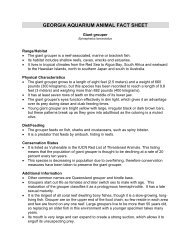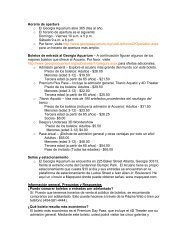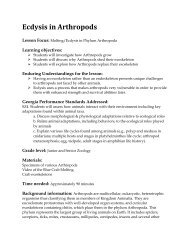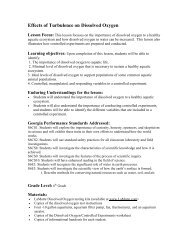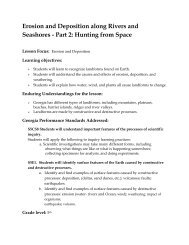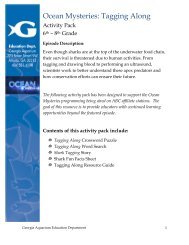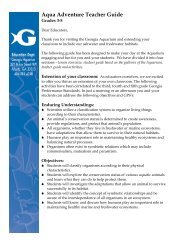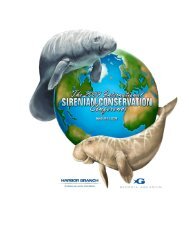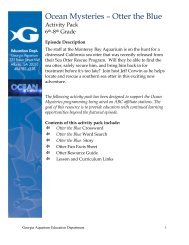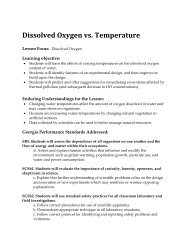Weird & Wild – - Georgia Aquarium
Weird & Wild – - Georgia Aquarium
Weird & Wild – - Georgia Aquarium
Create successful ePaper yourself
Turn your PDF publications into a flip-book with our unique Google optimized e-Paper software.
<strong>Weird</strong> & <strong>Wild</strong><br />
Teachers Guide<br />
Grades 3 rd -5 th<br />
Program Description:<br />
Come along on a “weird & wild” adventure at the <strong>Georgia</strong> <strong>Aquarium</strong>! During<br />
this program students will explore some of our galleries to discover the “weird<br />
and wild” characteristics of our unique animals. The students will visit some of<br />
our behind the scenes areas while learning how these animals are able to survive<br />
in their unique habitats.<br />
Enduring Understandings for <strong>Weird</strong> & <strong>Wild</strong>:<br />
<br />
<br />
<br />
Scientists utilize a classification system to organize living things according<br />
to their characteristics.<br />
All organisms have adaptations that allow them to survive in their natural<br />
habitats.<br />
Humans play an important role in maintaining healthy ecosystems and<br />
balancing natural processes.<br />
Objectives:<br />
<br />
<br />
<br />
<br />
Students will:<br />
Investigate the adaptations that allow an animal to survive successfully in<br />
its habitat.<br />
Classify organisms according to their physical characteristics.<br />
Be aware of the interdependence of all organisms in an ecosystem.<br />
Know and discuss how humans play an important role in maintaining<br />
healthy marine and freshwater ecosystems.<br />
<strong>Georgia</strong> Performance Standards Addressed:<br />
Third Grade<br />
S3CS4: Students will use ideas of system, model, change, and scale in exploring<br />
scientific and technological matters.<br />
a. Observe and describe how parts influence one another in things with many<br />
parts.<br />
S3L1: Students will investigate the habitats of different organisms and the<br />
dependence of organisms on their habitat.<br />
d. Explain what will happen to an organism if the habitat is changed.<br />
Fourth Grade<br />
S4CS4: Students will use ideas of system, model, change, and scale in exploring<br />
scientific and technological matters.<br />
a. Observe and describe how parts influence one another in things with many<br />
parts.<br />
<strong>Georgia</strong> <strong>Aquarium</strong> - Education Department 1
S4L1: Students will describe the roles of organisms and the flow of energy within an ecosystem.<br />
c. Predict how changes in the environment would affect a community (ecosystem) of<br />
organisms.<br />
S4L2: Students will identify factors that affect the survival or extinction of organisms such as<br />
adaptation, variation of behaviors (hibernation), and external features (camouflage and protection).<br />
a. Identify external features of organisms that allow them to survive or reproduce better than<br />
organisms that do not have these features.<br />
Fifth Grade<br />
S5CS4: Students will use ideas of system, model, change, and scale in exploring scientific and<br />
technological matters.<br />
a. Observe and describe how parts influence one another in things with many parts.<br />
S5L1: Students will classify organisms into groups and relate how they determined the groups with<br />
how and why scientists use classification.<br />
a. Demonstrate how animals are sorted into groups (vertebrate and invertebrate) and how<br />
vertebrates are sorted into groups (fish, amphibian, reptile, bird, and mammal).<br />
Pre-visit activities:<br />
1. Water Address <strong>–</strong> Students will identify aquatic animals and their habitats by analyzing clues<br />
that describe the animals’ adaptations.<br />
2. Awesome Aquatic Animals! <strong>–</strong> Students will learn the parts of a bony fish, shark, and whale;<br />
and compare and contrast the differences and similarities of each animal.<br />
Post-visit activities:<br />
1. Classification Station <strong>–</strong> Students will classify animals they saw at the <strong>Georgia</strong> <strong>Aquarium</strong>.<br />
<strong>Georgia</strong> <strong>Aquarium</strong> - Education Department 2
Water Address<br />
Adapted from the Project WET k-12 Curriculum & Activity Guide.<br />
Grade: 3 rd <strong>–</strong> 5 th<br />
Objective: Students will identify aquatic animals and their habitats by analyzing clues that<br />
describe the animals’ adaptations.<br />
Duration: 50 minutes<br />
Vocabulary: adaptation, camouflage, coral reef, fish, mammal, freshwater, saltwater, predator,<br />
prey<br />
Materials:<br />
<br />
<br />
<br />
<br />
<br />
10 sets of “Adaptation Cards” for each group of students<br />
pencils and paper for scorekeeping<br />
10 sets of animal picture cards (optional)<br />
10 sets of habitat cards (optional)<br />
globe or world map (optional)<br />
Background:<br />
Three-quarters of Earth’s surface is covered with water. There are many different types of aquatic<br />
habitats such as open ocean, coral reef, lakes, rivers, marshes, and swamps. To survive in these<br />
different environments animals have special features, or adaptations. These adaptations have<br />
developed over time and serve several important purposes. They can help an organism get food,<br />
protect themselves from enemies, and survive in many different conditions.<br />
There are many ways in which animals have adapted to surviving in aquatic habitats. Fish have<br />
streamlined bodies and fins to help them move through the water quickly. Their coloration helps<br />
them to hide from predators or helps predators sneak up on their prey. Some fish have added<br />
protections such as spines and spots on the back half of their bodies to confuse their predators. Fish<br />
also have gills so that they are able to filter the oxygen out of the water to breathe. Some aquatic<br />
birds have webbed feet for swimming as well as glands that produce waxy oil for waterproofing their<br />
feathers.<br />
Aquatic animals also have adaptations to allow them to survive in severe temperatures. For example,<br />
animals like belugas and sea lions have blubber (a thick layer of fat beneath their skin) to protect<br />
them from cold water. Sea otters do not have blubber, but they have very thick fur that serves the<br />
same function.<br />
Procedure:<br />
1. Discuss how Earth’s surface is covered with about 71% of water and demonstrate this using a<br />
globe or map. Aquatic habitats are home to thousands of species of animals. Tell the students<br />
<strong>Georgia</strong> <strong>Aquarium</strong> - Education Department 3
that today they are going to learn about different aquatic habitats, some of the animals that<br />
live there, and the adaptations that allow them to survive in their habitat.<br />
2. Make a list on the board with the students of all the aquatic habitats they can think of. Make<br />
sure to include both freshwater and saltwater habitats. (Discuss the difference between these<br />
two terms if necessary.)<br />
3. Tell the students that each one of these habitats includes animals that have adapted to the<br />
specific conditions of that habitat to be able to survive there. Have the students define<br />
adaptation. Give an example such as fish adapting to live in water by having gills.<br />
4. Tell the students they are going to play a riddle game in which they must guess an organism’s<br />
identity and “water address” (or habitat) based on the clues on the adaptation card. Have<br />
students form groups of three or four.<br />
5. Hand out a set of the “Adaptation Cards”, “Animal Cards”, and “Habitat Cards” to each<br />
group (last two sets are optional depending on your group). Instruct students to spread out<br />
the animal and habitat cards on their desks or floor.<br />
6. Explain that each card lists four adaptations of a certain animal. Based on the clues, students<br />
will match the animal and the habitat to the adaptations on the card (animal and habitat cards<br />
are an extra help for students).<br />
7. Each student in the group should take turns being the “reader”. The reader starts the game by<br />
picking an “Adaptation Card” and reading the clues one at a time until another student in the<br />
group correctly identifies the animal and the habitat (using the pictures for help). Answers are<br />
listed at the bottom of each card.<br />
8. The student who correctly guesses both the name of the organism and its water address<br />
(habitat) receives points for the group (a scorekeeper should keep track of the group’s points).<br />
Keep track of the score as follows:<br />
a. One clue read = four points<br />
b. Two clues read = three points<br />
c. Three clues read = two points<br />
d. Four clues read = one point<br />
9. Have the students continue playing the game and keeping track of the group’s score until all<br />
the adaptation cards have been used. The group then tallies up their score and when all<br />
groups have finished they can compare their score with other groups to determine a winner!<br />
10. To wrap up, make a list with the students of all the different water-related adaptations they<br />
learned about while playing the game.<br />
Assessment:<br />
<br />
<br />
<br />
Extension:<br />
<br />
Walk around the room while students are playing the game to make sure all are participating.<br />
Have students make a list of other animals that live in the aquatic habitats provided on the<br />
cards.<br />
Have students do a written reflection about what they learned during the activity.<br />
Students can create their own aquatic animal in a fictional water environment. Have them<br />
imagine special features or behaviors the animal would need to live in their environment. The<br />
students should draw a picture of the habitat and the animal as well as write a description.<br />
<strong>Georgia</strong> <strong>Aquarium</strong> - Education Department 4
The students should tell how the animal gets its food, how it protects itself, as well as other<br />
ways it is able to survive successfully in its habitat. They can evaluate each others work and<br />
offer suggestions.<br />
Resources:<br />
Project WET (Water Education for Teachers). 2006. 9/27/07 .<br />
Goodman, Susan E. Claws, Coats, and Camouflage. Minneapolis: Millbrook Press, 2001.<br />
Hewitt, Sally. All Kinds of Habitats. Danbury: Children’s Press, 1999.<br />
Rose, Elizabeth. Animal Adaptations for Survival. PowerKids Press, 2006.<br />
<strong>Georgia</strong> <strong>Aquarium</strong> - Education Department 5
Adaptation Card<br />
I am able to change the color of<br />
my skin to camouflage.<br />
I have no bones so I am able to<br />
squeeze into small spaces.<br />
The only hard part of my body is<br />
my beak which I use to eat and defend<br />
myself.<br />
I have strong suction cups which<br />
I use to grasp and hold on to things.<br />
Answer: Octopus- lives in the coral reef<br />
Adaptation Card<br />
I have no teeth but powerful<br />
jaws to crush food.<br />
My flippers help me to swim<br />
gracefully in the ocean.<br />
I cannot pull my head and<br />
flippers into my shell.<br />
I like to rest underneath rock<br />
ledges (which also protect me).<br />
Answer: Sea turtle <strong>–</strong> open ocean, coral reef<br />
Adaptation Card<br />
My body is covered in smooth<br />
scales so I can swim gracefully<br />
through the water.<br />
I am bright colors so I can blend<br />
in with my habitat.<br />
I have sharp spines located on<br />
both sides of my tail fin to defend<br />
myself from predators.<br />
When I am scared I will hide in<br />
small nooks and crannies.<br />
Answer: Tropical fish- lives in coral reef<br />
Adaptation Card<br />
I am grey or brown to blend in with<br />
my habitat.<br />
I breathe using gills, which take<br />
oxygen from the water.<br />
My mouth is located in the front of<br />
my body so I can catch other fish easily.<br />
I have a beard or “barbels” that help<br />
me to sense where my food is in the<br />
murky water.<br />
Answer: Catfish- lives in the river<br />
Adaptation Card<br />
My color often depends on the color<br />
of the water.<br />
I like to build a nest of mud or sand<br />
near brackish water.<br />
I am cold-blooded so I can live in a<br />
wide range of temperatures.<br />
I do not feed during the cooler<br />
months.<br />
Answer: Crocodile- swamp<br />
Adaptation Card<br />
My underside is light so that I can<br />
camouflage while swimming.<br />
I have gills on the underside of my<br />
body as well as holes on top of my head so I<br />
can breathe when lying on the ocean floor.<br />
I have tooth plates to crush things that<br />
live on the bottom of the ocean such as<br />
crabs.<br />
I use my fins to cover myself with<br />
sand to hide from predators.<br />
Answer- Cownose ray- lives in the open ocean<br />
<strong>Georgia</strong> <strong>Aquarium</strong> - Education Department 6
Adaptation Card<br />
I have webbed feet.<br />
I have glands that produce waxy<br />
oil that waterproofs my feathers.<br />
I have a wide, flat beak adapted<br />
for scraping the bottom of my habitat<br />
for food.<br />
I migrate to warmer areas in the<br />
winter for food and shelter.<br />
Answer: Duck- marsh, river<br />
Adaptation Card<br />
I move with the movement of the<br />
waves.<br />
I have stinging tentacles that help me<br />
catch my food.<br />
Being clear makes it hard for<br />
predators to see me.<br />
I have special “arms” that bring my<br />
food up to my “mouth”.<br />
Adaptation Card<br />
I move using hundreds of tiny<br />
tube feet all over my body.<br />
I have spines all over my body<br />
for protection.<br />
My color helps me to camouflage<br />
in my environment.<br />
I also use my spines to dig into<br />
stones to hide.<br />
Answer: Jelly- open ocean and/or coral reef<br />
Adaptation Card<br />
My light color helps me to<br />
camouflage in my habitat.<br />
Blubber helps keep my body heat<br />
inside.<br />
My teeth and flexible lips help me to<br />
eat animals off the ocean bottom.<br />
I can hold my breath for 20-25<br />
minutes!<br />
Answer: Sea urchin- coral reef<br />
Adaptation Card<br />
I am a fish that breathes with<br />
gills.<br />
I use my long snout to suck up<br />
tiny shrimp.<br />
I have fins for swimming located<br />
on my lower body and my head<br />
I give live birth from a pouch<br />
(males only!).<br />
Answer: Seahorse- coral reef<br />
Answer: Beluga whale- in the arctic (ocean)<br />
Adaptation Card<br />
I have gills that I use for breathing.<br />
I use my sharp teeth for catching and<br />
eating stingrays and other fish.<br />
The strange shape of my head helps<br />
me to maneuver through the water.<br />
My skin is made of tiny teeth that<br />
help to protect me.<br />
Answer: Hammerhead shark- open ocean, coral reef<br />
<strong>Georgia</strong> <strong>Aquarium</strong> - Education Department 7
ANIMAL CARDS<br />
<strong>Georgia</strong> <strong>Aquarium</strong> - Education Department 8
HABITAT CARDS<br />
CORAL REEF<br />
RIVER<br />
OPEN OCEAN<br />
ARCTIC<br />
<strong>Georgia</strong> <strong>Aquarium</strong> - Education Department 9
MARSH<br />
SWAMP<br />
<strong>Georgia</strong> <strong>Aquarium</strong> - Education Department 10
Awesome Aquatic Animals!<br />
Grade: 3 rd <strong>–</strong> 5 th<br />
Objective: Students will investigate the adaptations that allow an animal to survive successfully in<br />
its habitat.<br />
Duration: 45 minutes<br />
Vocabulary: Caudal fin, anal fin, dorsal fin, pectoral fin, lateral line, gills, pelvic fin, blowhole, dorsal<br />
ridge, flukes, melon, pectoral flipper, rostrum<br />
Materials:<br />
• “Frank the Fish” worksheet<br />
• “Shelly the Shark” worksheet<br />
• “Billy the Beluga” worksheet<br />
• Overheads of each unlabeled worksheet<br />
• Answer keys<br />
Background:<br />
There are many different types of organisms that live in aquatic environments. While they do all live<br />
underwater, they do not necessarily share the same body parts. For this lesson we are going to<br />
compare and contrast fish, sharks, and whales as each has adapted to survive in their aquatic habitat.<br />
Fish are cold-blooded animals that use gills to breathe. There are two types of fish: bony fish and<br />
cartilaginous fish. Bony fish have skeletons made of bones like humans. Cartilaginous fish, such as<br />
sharks and rays, have skeletons made of cartilage which is the flexible tissue that makes up our ears<br />
and nose. Some similarities and differences between the two types of fish include:<br />
While both types of fish have gills to breathe, bony fish have one gill opening covered by an<br />
operculum. Sharks have five to seven separate gill slits.<br />
Both bony fish and cartilaginous fish move their tail fin (caudal fin) left and right to move<br />
through the water. They use their pectoral fins to stop, move forward, or turn. Both use the<br />
dorsal fin for stability and to help the fish balance from side to side.<br />
Bony fish are covered with scales for protection and provide color. Cartilaginous fish,<br />
however, are covered with dermal denticles (modified teeth).<br />
Bony fish have lateral lines, or a row of sensory pores, that they use to determine differences in<br />
water pressure that could indicate a change in depth or approaching predators. Cartilaginous fish<br />
also have lateral lines as well as ampullae of lorenzini, which detect weak electromagnetic signals<br />
generated by prey. Sharks also have an excellent sense of smell, a trait that they do not share with<br />
bony fish.<br />
Whales are mammals, meaning they have hair, breathe air with their lungs, give birth to live calves,<br />
nurse their young, and are warm-blooded. Whales breathe through a blowhole on top of their head,<br />
and move their tails, or flukes, up and down to swim instead of side-to-side like a fish. Like fish,<br />
whales also use their pectoral flippers to stop, move forwards, or turn. However, unlike fish, whales<br />
<strong>Georgia</strong> <strong>Aquarium</strong> - Education Department 11
also use their flippers to thermoregulate <strong>–</strong> to warm or cool themselves to maintain their body<br />
temperature. Most whales have a dorsal fin, with the exception of the beluga and narwhal whales<br />
that live in the Arctic, where the water is often covered with ice. Instead, belugas have a hard dorsal<br />
ridge that runs along their back, used to break breathing holes in the ice when necessary.<br />
Whales are known to use echolocation to locate food and objects under the water. When a whale<br />
echolocates, it creates a high-pitched sound, usually in the form of a click or whistle, from the nasal<br />
passages located just inside its blowhole. It then concentrates and directs that sound with its melon,<br />
a round, fatty organ found on top of the whale’s head. The sound continues outward until it bounces<br />
off of an object and then echoes back to the whale, revealing where an object is located, the object’s<br />
shape, size, and how fast it is traveling.<br />
One of the most remarkable characteristics of whales is their ability to vocalize and create songs.<br />
Whale songs vary from simple clicks to complex vocalizations, with distinct beginnings and ends to<br />
the song, and can be heard for many miles under the water. Whales use songs to communicate with<br />
each other. For example, they use songs to find a mate or to keep track of their young.<br />
Procedure:<br />
1. Brainstorm with the students some aquatic animals they know. List them on the board.<br />
a. Challenge students to give specific animals and interesting characteristics that each has<br />
(ex. Hammerhead Shark has a flattened hammer-like head)<br />
2. After brainstorming, introduce the three specific types of aquatic animals that are pertinent to this<br />
lesson: bony fish, cartilaginous fish, and marine mammals. Explain the similarities and<br />
differences between them.<br />
3. Pass out the three worksheets and have students work in groups or individually to label the<br />
diagrams. Using an unlabeled overhead of each animal, have the students help you fill in the<br />
blanks and explain how each part is used.<br />
4. Have students go back to the list on the board to identify which animal on the list is a bony fish,<br />
cartilaginous fish, and which are marine mammals. Have students explain why the animal<br />
belongs there (hint: body parts).<br />
Assessment:<br />
Student participation in the worksheet and the group discussion.<br />
Extension:<br />
Have students complete a Venn diagram together on the board comparing two of the three<br />
types of aquatic animals discussed in this exercise. Bony and cartilaginous fish are<br />
recommended. Have the students discuss the similarities and differences between the two<br />
types of fish.<br />
<br />
Have students create their own unique aquatic animal based on what they have learned.<br />
Students should be challenged to be creative with their animal <strong>–</strong> create a hybrid fish/mammal.<br />
Once complete, students would show their animal to their peers and explain why they chose<br />
certain parts and how their animal would use those parts to survive in its environment.<br />
<strong>Georgia</strong> <strong>Aquarium</strong> - Education Department 12
Resources:<br />
Supplies can include crayons, markers, watercolors, construction paper, glitter, shiny plastic,<br />
fabric scraps, glue, and/or tape.<br />
Parker, Steve. Eyewitness Fish. 2005: DK Publishing Inc.<br />
MacQuitty, Miranda. Eyewitness Sharks. 2004. DK Publishing Inc.<br />
Reeves, Randall R., Brent S. Stewart, Phillip J. Clapham, & James A. Powell. National Audubon Society<br />
Guide to Marine Mammals of the World. 2002. Chanticleer Press, Inc.<br />
<strong>Georgia</strong> <strong>Aquarium</strong>. “Coldwater Quest: The Chilly Unknown <strong>–</strong> Beluga Whales.” 8/19/07<br />
http://www.georgiaaquarium.org/animalguide/coldwaterquest/belugawhale.aspx<br />
Mojetta, Angelo. Sharks. 2004: White Star Publishers<br />
<strong>Georgia</strong> <strong>Aquarium</strong> - Education Department 13
Frank the Fish<br />
Read the definitions, and then label the fish diagram below. (Note: not all fish have all of<br />
the fins defined below.)<br />
anal fin - the fin on the lower side of the<br />
body near the tail<br />
caudal fin - the tail fin<br />
dorsal fin - the fin on the upper side of<br />
the body<br />
eye - sight organs located on the head<br />
gills - fleshy organs that are used for<br />
breathing - they are located on the side<br />
of the head<br />
lateral line - a series of sensory pores (small openings)<br />
that are located along the sides of fish - they sense<br />
vibrations in the water<br />
mouth - the part of the body which the fish uses to catch<br />
food - it is located at the front of the body<br />
pectoral fin - each of the paired fins on either side of the<br />
body, near the head<br />
pelvic fin - each of the paired fins on the lower side of the<br />
body, near the head<br />
Copyright ©2001-2007 EnchantedLearning.com<br />
<strong>Georgia</strong> <strong>Aquarium</strong> - Education Department 14
Shelly the Shark<br />
Read the definitions, and then label the shark diagram below. (Note: not all sharks have<br />
all of the parts defined below.)<br />
anal fin - the fin on the lower side of the<br />
body near the tail (not on all sharks)<br />
caudal fin - the tail fin<br />
eye - sight organs located on the head<br />
first dorsal fin - the fin on the upper side<br />
of the body nearest the head<br />
gills - fleshy organs that are used for<br />
breathing - they are located on the side<br />
of the head<br />
mouth - the part of the body which the<br />
fish uses to catch food - it is located at<br />
the front of the body<br />
nostril - paired slits on the underside of the snout. Water<br />
continually flows through the nostrils, giving the shark<br />
olfactory (sense of smell) information. Unlike humans,<br />
shark nostrils have nothing to do with breathing - they<br />
are not even connected to the mouth.<br />
pectoral fin - each of the paired fins on either side of the<br />
body, near the head<br />
pelvic fin - each of the small, paired fins on the lower rear<br />
side of the body<br />
second dorsal fin - the fin on the upper side of the body<br />
nearest the tail<br />
snout - the front part of the shark's head<br />
Copyright ©2001-2007 EnchantedLearning.com<br />
<strong>Georgia</strong> <strong>Aquarium</strong> - Education Department 15
Billy the Beluga<br />
Read the definitions, and then label the beluga diagram below. (Note: not all whales have<br />
all of the parts defined below.)<br />
blowhole <strong>–</strong> hole on the top of the head that<br />
whales breathe air through<br />
dorsal ridge - the raised area in the center of<br />
the back used to break holes in the ice<br />
eye - sight organs located on the head<br />
flukes <strong>–</strong> the two lobes that make up the tail<br />
of the whale<br />
melon <strong>–</strong> the rounded structure on the top of the head<br />
located in front of the blowhole.<br />
pectoral flipper <strong>–</strong> each of the paired fins on either side<br />
of the body, near the head<br />
rostrum <strong>–</strong> the part of the body which the whale uses to<br />
catch food <strong>–</strong> it is located at the front of the body<br />
Copyright ©2001-2007 EnchantedLearning.com<br />
<strong>Georgia</strong> <strong>Aquarium</strong> - Education Department 16
Frank the Fish <strong>–</strong> Answer Key<br />
Read the definitions, and then label the fish diagram below. (Note: not all fish have all of<br />
the fins defined below.)<br />
anal fin - the fin on the lower side of the<br />
body near the tail<br />
caudal fin - the tail fin<br />
dorsal fin - the fin on the upper side of<br />
the body<br />
eye - sight organs located on the head<br />
gills - fleshy organs that are used for<br />
breathing - they are located on the side<br />
of the head<br />
lateral line - a series of sensory pores (small openings)<br />
that are located along the sides of fish - they sense<br />
vibrations in the water<br />
mouth - the part of the body which the fish uses to catch<br />
food - it is located at the front of the body<br />
pectoral fin - each of the paired fins on either side of the<br />
body, near the head<br />
pelvic fin - each of the paired fins on the lower side of the<br />
body, near the head<br />
Copyright ©2001-2007 EnchantedLearning.com<br />
<strong>Georgia</strong> <strong>Aquarium</strong> - Education Department 17
Shelly the Shark <strong>–</strong> Answer Key<br />
Read the definitions, and then label the shark diagram below. (Note: not all sharks have<br />
all of the parts defined below.)<br />
anal fin - the fin on the lower side of the<br />
body near the tail (not on all sharks)<br />
caudal fin - the tail fin<br />
eye - sight organs located on the head<br />
first dorsal fin - the fin on the upper side<br />
of the body nearest the head<br />
gills - fleshy organs that are used for<br />
breathing - they are located on the side<br />
of the head<br />
mouth - the part of the body which the<br />
fish uses to catch food - it is located at<br />
the front of the body<br />
nostril - paired slits on the underside of the snout. Water<br />
continually flows through the nostrils, giving the shark<br />
olfactory (sense of smell) information. Unlike humans,<br />
shark nostrils have nothing to do with breathing - they<br />
are not even connected to the mouth.<br />
pectoral fin - each of the paired fins on either side of the<br />
body, near the head<br />
pelvic fin - each of the small, paired fins on the lower rear<br />
side of the body<br />
second dorsal fin - the fin on the upper side of the body<br />
nearest the tail<br />
snout - the front part of the shark's head<br />
Copyright ©2001-2007 EnchantedLearning.com<br />
<strong>Georgia</strong> <strong>Aquarium</strong> - Education Department 18
Billy the Beluga <strong>–</strong> Answer Key<br />
Read the definitions, and then label the beluga diagram below. (Note: not all whales have<br />
all of the parts defined below.)<br />
blowhole <strong>–</strong> hole on the top of the head that<br />
whales breathe air through<br />
dorsal ridge <strong>–</strong> the raised area in the center of<br />
the back used to break holes in the ice<br />
eye <strong>–</strong> sight organs located on the head<br />
flukes <strong>–</strong> the two lobes that make up the tail<br />
of the whale<br />
melon <strong>–</strong> the rounded structure on the top of the head<br />
located in front of the blowhole.<br />
Pectoral flipper <strong>–</strong> each of the paired fins on either side<br />
of the body, near the head<br />
rostrum <strong>–</strong> the part of the body which the whale uses to<br />
catch food <strong>–</strong> it is located at the front of the body<br />
Copyright ©2001-2007 EnchantedLearning.com<br />
<strong>Georgia</strong> <strong>Aquarium</strong> - Education Department 19
Classification Station!<br />
Grade Level: 3 rd <strong>–</strong> 5 th<br />
Objective: Students will classify animals that they saw at the <strong>Georgia</strong> <strong>Aquarium</strong>.<br />
Duration: 30 minutes<br />
Vocabulary: Mammal, Fish, Reptile, Arthropod, Cnidarian, Invertebrate, Vertebrate, Cartilage<br />
Materials:<br />
Copy of Classification Title Cards (to be hung on a board)<br />
Copy of the Animal Cards and Tape<br />
Background:<br />
All animals are classified using a scientific system. The system is Kingdom, Phylum, Class, Order,<br />
Family, Genus and Species. Scientists use this system to help them understand the anatomy,<br />
genetics, and relatives of animals. Scientists classify animals according to various characteristics such<br />
as skeleton, breathing, coverings, teeth, and feet. In the animal world this includes Mammalian,<br />
Osteichthyes (ex. bony fish), Chondrichthyes (ex. sharks and rays), Reptilian (ex. alligators),<br />
Arthropod (ex. crabs), and Cnidarians (ex. coral).<br />
Procedure:<br />
1. Make a copy of the Classification Title Cards and a copy of the Animal Cards and place tape on<br />
the back of each card.<br />
2. Hand out an animal card to each student. (If there are not enough animal cards you can hold up<br />
cards and place them in the category that the students call out.)<br />
3. Hang Classification Title Cards up on a board. Start with Mammal, Fish, Reptile, etc... (You can<br />
keep the characteristics attached if you would like or take them off to challenge the students.)<br />
Then let students put the animal cards in the correct category.<br />
4. Remove the Mammal, Reptile, etc… cards; then hang up the Invertebrate and Vertebrate Cards<br />
and repeat with the animal cards.<br />
5. Remove the Invertebrate and Vertebrate cards; then hang up Cartilaginous and Bony Fish Cards<br />
and repeat with just the FISH animal cards.<br />
6. This activity can be done in small groups or as a whole class; just make a set of Classification Title<br />
Cards and Animal Cards for each small group.<br />
Assessment:<br />
On a separate piece of a paper, have the students write down 5 more animals (that aren’t on the<br />
cards) for each category of Mammal, Reptile, Arthropod, and Fish.<br />
Have the students pick one of the animals from the animal cards and write a 1 to 2 page report on<br />
that animal, including where the animal lives, what it eats, its adaptations, its conservation status and<br />
how they can help protect that animal.<br />
Resources:<br />
Gilopin, Daniel and Parker, Steve. 2006. Animal Kingdom Classification Series, Compass Point Books.<br />
<strong>Georgia</strong> <strong>Aquarium</strong> - Education Department 20
National Park Service. Aliens in your neighborhood; 9/27/07;<br />
http://www.nps.gov/invspcurr/alienXIDactivities.htm<br />
<strong>Georgia</strong> <strong>Aquarium</strong> - Education Department 21
Classification Title Cards<br />
Classification Title Cards<br />
Warm<br />
Blooded<br />
Mammal<br />
Vertebrate<br />
Hair or<br />
Fur on<br />
Body<br />
Mother gives milk<br />
to offspring<br />
Arthropod<br />
Cold blooded Invertebrate<br />
Segmented<br />
bodies with<br />
jointed limbs<br />
Cold<br />
blooded<br />
Vertebrate<br />
Fish<br />
Scales on<br />
body<br />
Gills for<br />
breathing<br />
Reptile<br />
Cold<br />
blooded<br />
Vertebrate<br />
Scales on<br />
body<br />
Lungs for<br />
breathing<br />
Cnidarian<br />
Radial<br />
symmetry<br />
Invertebrate<br />
Stinging cells<br />
<strong>Georgia</strong> <strong>Aquarium</strong> - Education Department 22
Vertebrate<br />
Animal with backbone or spinal column<br />
Invertebrate<br />
Animal without a backbone or spinal column<br />
Bony Fish<br />
Skeleton composed of bone<br />
Cartilaginous Fish<br />
Skeleton composed of cartilage<br />
<strong>Georgia</strong> <strong>Aquarium</strong> - Education Department 23
Beluga Whale<br />
California Sea Lion<br />
Asian Small Clawed Otter<br />
Sea Turtle<br />
Jelly<br />
Japanese Spider Crab<br />
Weedy Sea Dragon<br />
Coral<br />
<strong>Georgia</strong> <strong>Aquarium</strong> - Education Department 24
Moorish Idol<br />
Sawfish<br />
Grouper<br />
Stingray<br />
Zebra Shark<br />
Hammerhead Shark<br />
Catfish<br />
Turtle<br />
Alligator Gar<br />
Whale Shark<br />
<strong>Georgia</strong> <strong>Aquarium</strong> - Education Department 25
Sea Anemone<br />
Sea Otter<br />
Horseshoe Crab<br />
Humphead Wrasse<br />
Guitarfish<br />
Black tip reef shark<br />
<strong>Georgia</strong> <strong>Aquarium</strong> - Education Department 26
Classification Answer Key<br />
Fish:<br />
<br />
<br />
<br />
<br />
<br />
<br />
<br />
<br />
<br />
<br />
<br />
<br />
<br />
Zebra Shark<br />
Whale Shark<br />
Sawfish<br />
Grouper<br />
Stingray<br />
Humphead Wrasse<br />
Guitarfish<br />
Black Tip Reef Shark<br />
Catfish<br />
Hammerhead Shark<br />
Weedy Sea Dragon<br />
Alligator Gar<br />
Moorish Idol<br />
Mammal:<br />
Beluga Whale<br />
Asian Small Clawed Otter<br />
Sea Otter<br />
California Sea Lion<br />
Arthropod:<br />
Japanese Spider Crab<br />
Horseshoe Crab<br />
Reptile:<br />
Turtle<br />
Sea Turtle<br />
Cnidarian:<br />
Coral<br />
Jelly<br />
Sea Anemone<br />
Vertebrate:<br />
Zebra Shark<br />
Whale Shark<br />
Sawfish<br />
Stingray<br />
Grouper<br />
Humphead Wrasse<br />
Weedy Sea Dragon<br />
Black Tip Reef Shark<br />
Catfish<br />
Alligator Gar<br />
Hammerhead Shark<br />
Sea Turtle<br />
Turtle<br />
Guitarfish<br />
Sea Otter<br />
Asian Small Clawed Otter<br />
California Sea Otter<br />
Beluga Whale<br />
Moorish Idol<br />
Invertebrate:<br />
Japanese Spider Crab<br />
Coral<br />
Jelly<br />
Horseshoe Crab<br />
Sea Anemone<br />
Cartilaginous Fish:<br />
Zebra Shark<br />
Whale Shark<br />
Sawfish<br />
Stingray<br />
Guitarfish<br />
Black Tip Reef Shark<br />
Hammerhead Shark<br />
Bony Fish:<br />
Grouper<br />
Catfish<br />
Leafy Sea Dragon<br />
Humphead Wrasse<br />
Alligator Gar<br />
Moorish Idol<br />
<strong>Georgia</strong> <strong>Aquarium</strong> - Education Department 27
<strong>Georgia</strong> <strong>Aquarium</strong> - Education Department 28



